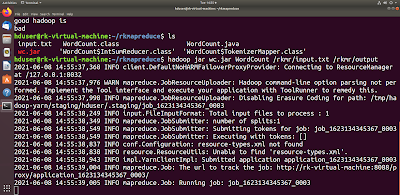# Program on WordCount.java
import java.io.IOException;
import java.util.StringTokenizer;
import org.apache.hadoop.conf.Configuration;
import org.apache.hadoop.fs.Path;
import org.apache.hadoop.io.IntWritable;
import org.apache.hadoop.io.Text;
import org.apache.hadoop.mapreduce.Job;
import org.apache.hadoop.mapreduce.Mapper;
import org.apache.hadoop.mapreduce.Reducer;
import org.apache.hadoop.mapreduce.lib.input.FileInputFormat;
import org.apache.hadoop.mapreduce.lib.output.FileOutputFormat;
public class WordCount
{
public static class TokenizerMapper
extends Mapper<Object, Text, Text, IntWritable>
{
private Text word = new Text();
private final static IntWritable one = new IntWritable(1);
public void map(Object key, Text value, Context context)
throws IOException, InterruptedException
{
StringTokenizer itr = new StringTokenizer(value.toString());
while (itr.hasMoreTokens())
{
word.set(itr.nextToken());
context.write(word, one);
}
}
}
public static class IntSumReducer
extends Reducer<Text,IntWritable,Text,IntWritable>
{
private IntWritable result = new IntWritable();
public void reduce(Text key, Iterable<IntWritable> values, Context context)
throws IOException, InterruptedException
{
int sum = 0;
for (IntWritable val : values)
{
sum += val.get();
}
result.set(sum);
context.write(key, result);
}
}
public static void main(String[] args)
throws Exception
{
Configuration conf = new Configuration();
Job job = Job.getInstance(conf, "word count");
job.setJarByClass(WordCount.class);
job.setMapperClass(TokenizerMapper.class);
job.setCombinerClass(IntSumReducer.class);
job.setReducerClass(IntSumReducer.class);
job.setOutputKeyClass(Text.class);
job.setOutputValueClass(IntWritable.class);
FileInputFormat.addInputPath(job, new Path(args[0]));
FileOutputFormat.setOutputPath(job, new Path(args[1]));
System.exit(job.waitForCompletion(true) ? 0 : 1);
}
}
javac -classpath `hadoop classpath` -d /home/hduser/rkmapreduce/ WordCount.java
Step 3: create a jar file wc.jar in the directory rkmapreduce as shown
jar -cvf wc.jar -C /home/hduser/rkmapreduce/ .
Step 4: create an input file input.txt that we need to check the wordcount of it as shown
Step 5: Now place the created input file input.txt into hadoop cluster by creating a directory rkmr in it as shown
hdfs dfs -put /home/hduser/rkmapreduce/input.txt /rkmr
Now we can check the content of the file rkmr/input.txt using the command
hdfs dfs -cat /rkmr/input.txt
Step 6: Now run the command hadoop jar to WordCount the file as shown
hadoop jar wc.jar WordCount /rkmr/input.txt /rkmr/output
Step 7: Now we can check the output of wordcount program using the following command
hdfs dfs -lsr /rkmr
hdfs dfs -cat /rkmr/output/part*





















































